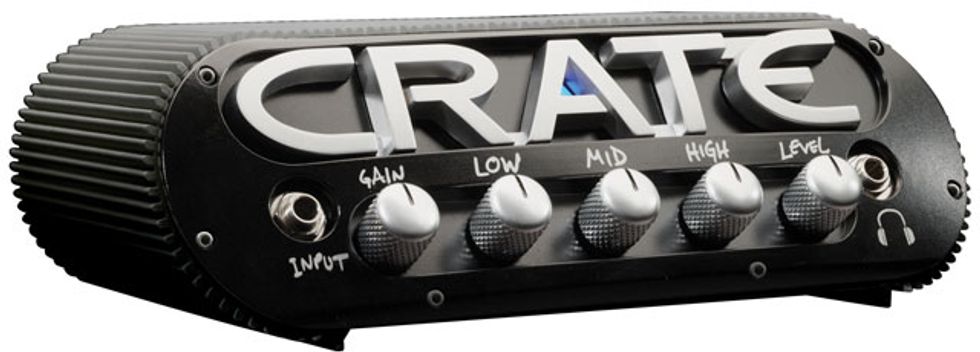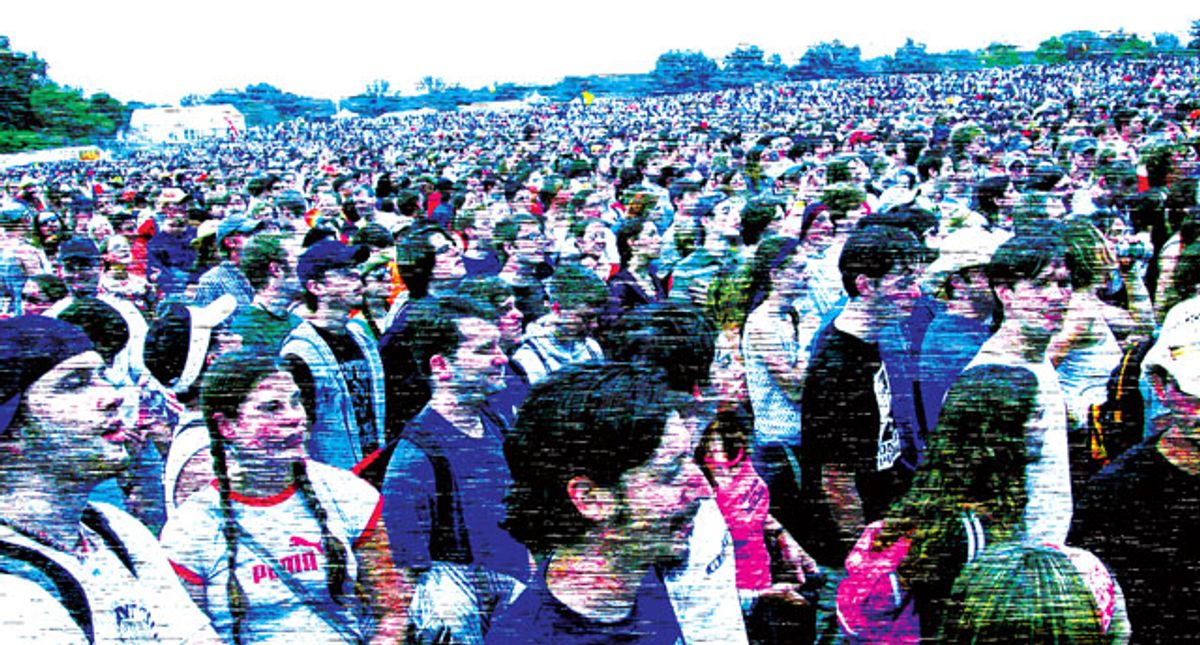
Because life on the road can be like walking a thin tightrope, Premier Guitar offers up some tried-and- true guidelines for the working musician.
For normal, upright citizens, summer translates to lazy days at the beach, toes in the sand, trashy novel in hand—a full-on vacation. For musicians, however, summer means tours, or what I like to call play-cation. For more than 20 years I’ve spent my sweaty June, July, and August months touring, from the grand and sublime to the cheap and crappy—there’s no bar too far, no hall too small. In the best of all possible worlds, I’m playing great music with good friends while seeing the world. Worst-case scenario: I’m playing rubbish with sleazebags and seeing my worst tendencies take over my personality. Although we often cannot control where life takes us, we can, with some effort, control our response. Admittedly I’m a slow learner, but occasionally I learn from my mistakes and have, through trial and error, come up with a few guidelines and rules that have helped me avoid disaster and make the most of my touring adventures. This personal protocol may not be for everyone, but it works for me (when I choose to follow it).
1. Simplify Your
Pedalboard
I used to approach a summer
tour like a good Boy Scout,
prepared for anything. My
pedalboard kept getting bigger
to accommodate every
sonic scenario. But as my gear
bounced around in trailers,
buses, vans, and airplanes,
come soundcheck my rig gave
me nothing but buzz and hum
and I often spent an inordinate
amount of time chasing down
shorts in my signal path. After
a while, I never really trusted
my pedalboard. Every time I
stomped on a pedal during a
show, I would worry that the
whole rig would shut down.
Not only was my instrument
untrustworthy, my tone subtlety
became smaller and frailer. It
was time to simplify and get rid
of all non-essentials.
Guitar tone really comes
down to four sounds:
1. Clean
2. Dirty
3. Delay
4. Swirly
When the pragmatic reality of limited tone options sank in, I was able to shrink my big tour pedalboard from 10 tone-sucking time bombs to a Spartan six pedals. Now, I can usually get by with, in this order: a tuner, a compressor, an overdrive, a delay, a phaser, and a tremolo. I used to feel that I needed many shades of dirt, from the subtle slight overdrive to the insane-inthe- membrane howl. I used to run two dirt boxes in line with varying degrees of filth, switching between them or engaging both simultaneously depending on the song. In an effort to trim the fat, I now only allow myself one dirt box, rolling on more sludge and slime with the spin of a tiny knob as I need it.
Swirly could be anything from a phaser, a flanger, a chorus, a Uni-Vibe or any other kooky, oddball effect. There’s weird stuff like this being invented everyday, and it’s a lot of fun to experiment with these sounds both live and in the studio. That said, those subtleties are often lost in a live setting, and when you schlep this stuff around long enough, it breaks.
A phaser is my weirdo effect of choice. Sure, it’s a bit cheesy, but it can sound a bit like a flanger or Uni-Vibe or even a bit like an overdone chorus. It may not be what you would choose in the studio where you have unlimited options, but for me it is a good flavor that says to the audience, “Hey, check out this freaky sound.” It fits me. I work primarily in country music, where tremolo remains an integral part of that classic sound. It’s just something I have to have. I love a good amp tremolo but regrettably my current amps of choice do not have it, so I go with a good ol’ stomp version.
If wah is your thing, bring it along and put up with the hassle. For years I carried one with me all the time, but found that this pedal was more likely to go bad than anything else (perhaps because when it is engaged, it’s violently rocking back and forth the entire time it’s used, rather than just turned on and off when needed). I eventually grew disgusted with the snap, crackle, pop of shorting cables and wah pedals so I abandoned the wah all together on tour. I have that sound for studio stuff, but only hook it up as needed. I also found that if I went to the trouble of bringing a wah to a gig, I would wha-ka-whaa-ka-whaa all night long like a ’70s cop show. I’m sure it annoyed the wits out of my poor bandmates.
The smaller pedalboard not only saves me a lot of breakdowns, worry, and nuisance on the road, but it helped me develop my own sound and style. When touring, I used to want to sound just like whoever played on the record, now I just want to sound consistently good. Having fewer tone options forced me to do my own thing.
2. Belts and
Suspenders:
Bring Backup Gear
for Your Tour
Whenever possible, I try to
bring a backup amp and guitar
to any important gig. I’m almost
guaranteed to break a string
within the first three bars of the
first song in a long set if I only
brought one guitar with me.
However, if I have guitar No. 2
tuned up and waiting in a stand
next to my amp, my No. 1 will
perform flawlessly all night,
every night. Reinforcements
take the worry away.
Like a curmudgeon grandfather, a tube amp tends to get cranky when traveling. I’ve taken to carrying a tiny, solid-state head with me on most road gigs. I travel with an old-ish Crate PowerBlock amp, which, like many great pieces of gear, is no longer made but can be found used for around $100. This amp is about the size of a Katz’s Deli Reuben sandwich. It fits neatly in the side pocket of my amp head case, or in the front pocket of my guitar gig bag, but I usually stuff it in back of whatever combo amp I’m using (this is kind of a stupid, lazy way to do it since it could bounce around in there and smash tubes if the amp falls or is flipped upside down). I often leave the Crate resting on top of whatever amp I’m using just in case things go bad. If at any point during a gig my amp begins to crackle, hum, smoke, or burst into flames, I can unplug the 1/4" speaker line from my tube amp and put it into the Crate. Then I can do the same for the 1/4" guitar cable, turn on the Crate for immediate power (no wait for the tubes to heat up) and be up and rocking in less then a minute. It’s easy for the engineer because the same speaker means no re-mic’ing needed.
An added benefit of carrying an additional rig on your summer tour is it helps break up stagnant playing. When I play the same guitar and amp all the time, I tend to also play the same note patterns all the time. Getting a different tone and having a different feel in your hands alters your musical approach. It may not be comfortable, but it could render something great.
This compact Crate PowerBlock amp is no longer in
production, but you can get a used one for around $100.
It’s easy to get bogged down in tone snobbery. Many of us would rather find a pustulant boil on our genitals than find a solid-state amp as our only source of sound on a big gig. But we’re not talking first choices here, we are talking survival, or getting through a gig when our “A” rig goes belly up. I’m sure there are hundreds of serviceable options for a small, cheap backup amp, but here are a few suggestions.
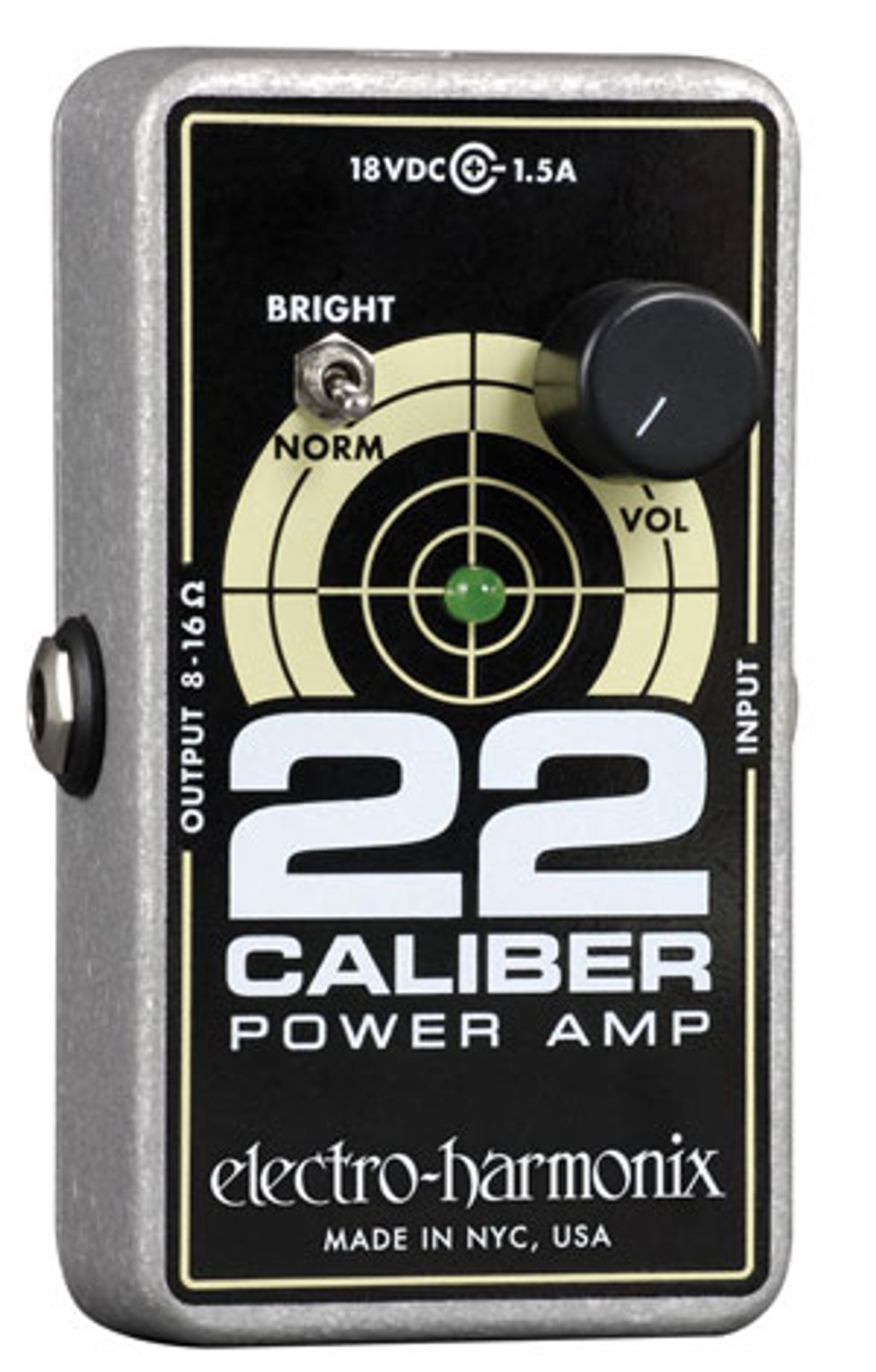
Electro Harmonix 22 Caliber
22 watts
Stree price: $104
This thing is tiny, about the size of a smallish pedal. It’s cheap as you could hope for and sounded good online. Worth a look.
ZT Lunchbox
200 watts
Street price: $245
This is a “friend of a friend” recommendation. I’ve never even seen this amp, but the size works and I’m told that it sounds great and can keep up with loud drums.
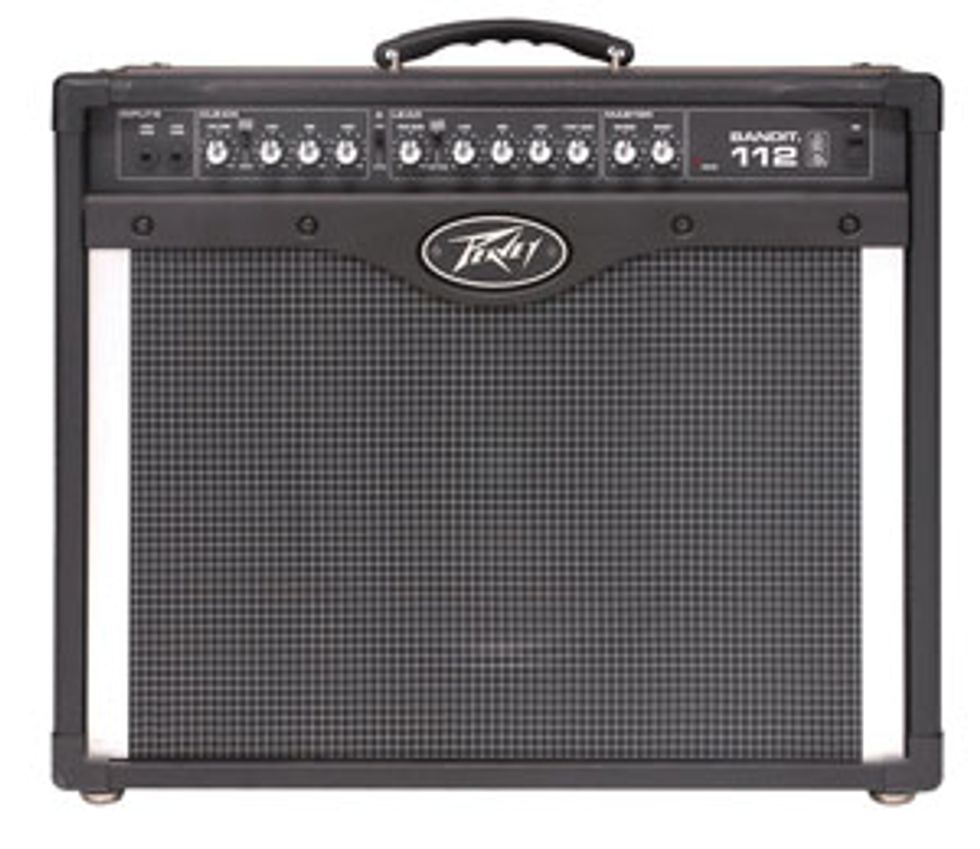
Peavy Bandit 112
80 watts
Street price: #349.99
(find secondhand for
as little as $50)
A combo amp but can drive any cabinet. There’s nothing pretty about this amp, but it is cheap and nearly indestructible. Pick a used one up for $50 and leave it in your trunk just in case. I actually saw Keith Urban play through one of these with his old band, The Ranch, and he sounded like… well … Keith Urban.
Traynor Quarterhorse
25 watts
Street price: $239
The size of a largeish stomp box, this amp can plug into a 4x12 cab and rawk. Or run the headphone out directly into a board for a convincing speakersimulated sound.
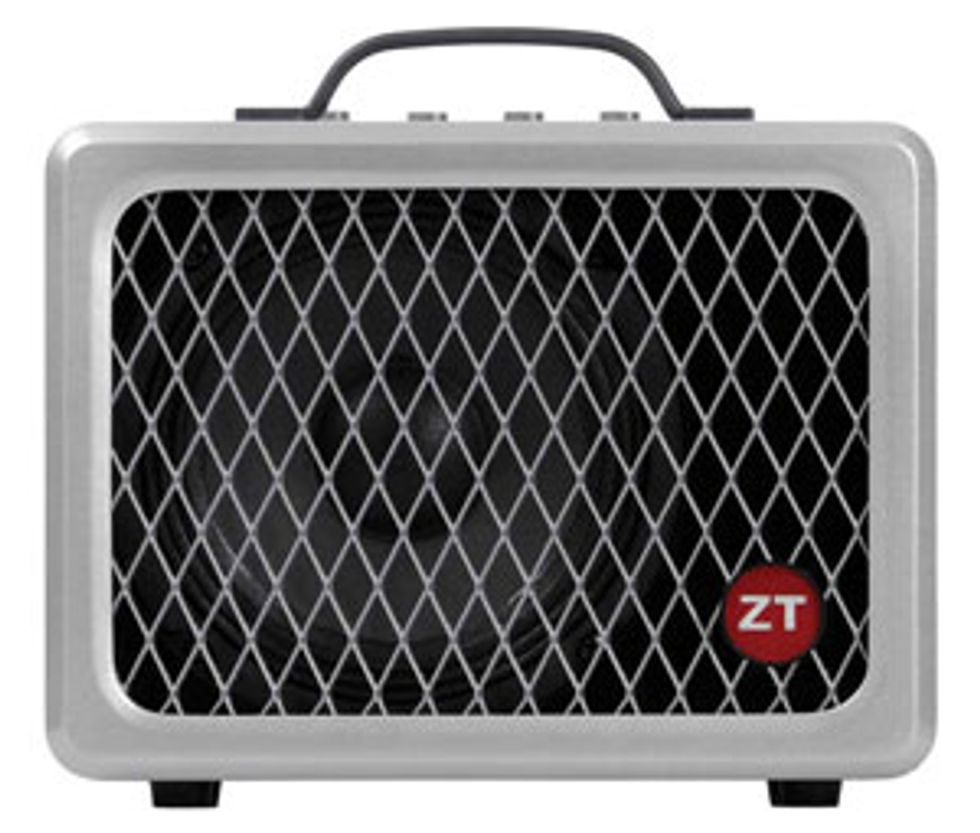
Diago Little Smasher
5 watts
Street price: $189
Though I’ve not played through this head, the size and simplicity appeals to me. A meager 5 watts may not be able to keep up with the band, but in a pinch, this could get you through.
Fender solidstate
Tweed
Bronco
15 watts
Street price: No longer
in production,
around $50 to $120
used
15 watts Street price: No longer in production, around $50 to $120 used A combo amp with a measly 5" speaker, this sounds great when driving a 4x12. Very small and light. I’ve used this for everything from guitar to pedal steel to bass. Sounds great, less filling.
3. Leave Your Top-Shelf Rig at Home
If you read Premier Guitar
you probably have stuff …
lots and lots of stuff: multiple
amps, guitars, stomp boxes, etc.
Assuming that’s the case, you
may reconsider touring with
your best gear. Gear is made to
be played, but regrettably, the
road is like Ike Turner, constantly
handing out a beating. Your
“best” stuff will soon become
your “okay” stuff, eventually
downgrading to your “not working”
stuff. I only use my favorite
amps for recording and travel
with my “B” amps. As abysmal
as it is to have your amp die on
tour, having your best amp not
work at a session is worse.
Guitars aren’t as susceptible to breaking down as amps are, but they are more likely to be stolen. Escaping unnoticed with a hefty amp is difficult, but it’s relatively easy to grab a guitar and run. I’ve never lost a guitar on the road, but I know people who have had their beloved axes stolen right off the stage, out of a van or hotel room, or even taken in the airport. I do bring out some favorite guitars on the road, but I try to never let them leave my sight.
Sinister Sun
For a crowd of bikini clad, cold drink chugging, Frisbee chucking, SPF-50 caked concertgoers, the sun means good times with possible dehydration and burning. For us onstage, the sun is a sinister force that can detune instruments and bake electronics to the point of failure while rendering LEDs useless. Here are some tips to beat the heat.
- Avoid leaving your guitar in direct sunlight when not playing. Find a shady spot that’s safe and leave it on a stand, if possible, so it can acclimate to the heat. (One bit of warning, if it’s a festival with many acts and a big crew stomping around, your guitar may be in danger of getting smacked off a stand. If that’s the case, leave it in the case.) Avoid carrying your guitar into an air-conditioned backstage area between soundcheck and gig or your sweet 6-string baby will remain hopelessly out of tune for the entire show.
- Push your pedalboard as close as possible to your monitor so the overhangs of the monitor will shade your pedals. This will hopefully make your pedal’s LEDs and tuner visible. (This is where a small, skinny board comes in handy). Though I’ve never used that clip-on-the-headstock tuner, this could be a big help.
- Both solid-state and tube amps left in the sun can shut down from the heat. Your best bet is to try to get them in the shade, perhaps in the side stage if need be. This may not be ideal for your performance but it’s better that having your amp crap out mid-show. Though I usually leave a tube amp on standby from soundcheck, I shut her down during hot, sunny shows.
4. Shop for Gear in
Every Town
Here’s a touring tip we can all
get enthusiastic about: Look for
gear in every town you visit while
touring. One might think that
with our current world market
of eBay, the days of discovering
bargains on the road are gone,
but that’s not the case. Deals exist
everywhere. I check the local
Craigslist, mom-and-pop music
stores, thrift shops, and even
garage sales in every town I can.
Here are a few examples of
recent road scores:
• Ventura, California,
two years ago: One
wouldn’t peg this exotic
locale—with a high cost
of living and plenty of
musicians—as a haven for
pawnshop bargains. But
in this pretty coastal town,
I found a Fender lap steel
from the early ’50s for
$70. The knobs, pots, and
the pickup on this instrument
alone are worth four
times that amount. Even
if I never wanted to play
lap steel, I could part this
thing out for a tidy profit
and still have the basic
wood of an incredibly cool
instrument, which I could
turn into a lamp, wall
hanging or cutting board
for my kitchen.
• Seattle, Washington,
two weeks ago: I found
a hard-shell guitar case
at Goodwill for $1.50
that perfectly fits a dreadnought.
Because airlines
crush cases every year, I
bought it even though I
currently don’t need one
because I will before long.
• St. Louis, Missouri, last
summer: While touring
with my wife in the town
that gave us Chuck Berry,
we found a cool accordion
on Craigslist for $60. The
seller was kind enough to
meet us near a downtown
restaurant where we were
lunching. After lunch,
bellies full, accordion in
tow, we stumbled onto a
little music store where we
found a great violin that
had been hanging on the
wall so long that they forgot
it was there. Although
the price tag said $450, the
guy behind the counter was
sick of looking at it and
said, “Make me an offer.”
We bought it for half the
price. During the haggling,
our bandmate discovered
a cache of old ribbon mics
adorning the rafters, more
as decoration then inventory.
We asked the clerk
how much and he dumped
the old mics so cheap that
I can’t even remember
what we paid. Who knows
what was going on in that
store—maybe the guy
really needed money, or
maybe he was a disgruntled
employee sticking it to the
man (I hope not). Maybe
that’s just how they do it in
St. Louie, but we walked
with some bargains.
5. Get out of
Your Hotel
Another benefit to searching
for road gear: It gives you an
opportunity to see the sights.
Paradoxically, being on the road
can make one a shut-in—traveling
musicians tend to only see
their hotel and venue of each
town they visit. Exploring gets
you out and moving instead of
lying all day in a questionable
rented bed with the curtains
drawn and TV blaring in some
dingy hotel. If you have any
say in the matter, try to book
hotels in the center of town,
walking distance to the sights
and shopping.
You work in the arts, so what the heck? Check out the local museums and galleries. Don’t limit your culture to the yogurt you eat at your hotel’s continental breakfast.
6. Utilize Apps
My phone has become
my most valuable tour tool
thanks to free apps that are
like having a tour manager in
your pocket. The GPS app gets
me to the gig, a sleep machine
app drowns out hotel noise,
a toilet finder helps on long
walks through foreign cities, a
translator app helps me communicate
when overseas or in
Los Angeles, and a flashlight
app lights my way through
dark stages. I have apps from
my favorite airlines for booking
flights, checking in and
keeping track of my miles.
iParking helps me find my
car. My bank has an app so I
can transfer money and know
when checks arrive back home.
All this as well as a great metronome
and tuner, what else
could you want?
7. Easy on the Booze,
Pound the H2O
A guy I know played a summer
punk festival tour that included
The Misfits in its cavalcade of
semi-stars. He imagined these
punk pioneers would be out of
their collective minds. Much to
his surprise, The Misfits spent
all of their time working out
and drinking bottle after endless
bottle of water. That discipline
(along with the deal they cut
with Satan) is probably responsible
for the group’s incredible
longevity. Limiting your booze
intake, particularly during hot
August festivals, can save your
life. Mix a few drinks with
intense heat and you might not
make it through the show. Have
lots of drinks on a hot stage and
you may be in the emergency
room when the rest of the band
goes on for an encore.
Though climate controlled, club tours are even more dangerous because club owners aren’t selling music, they are selling booze, and they want you to help. When club owners send drinks to the stage, their hope is the audience will watch you shoot it down and be inspired to match you drink for drink. The club doesn’t care about how this affects your health—they’re just looking for big sales. Don’t feel obligated to chug everything that’s sent your way. Raise the glass in a toast and toss it over your shoulder if you must.
8. Don’t Use
a House Mic
Germs. Those ubiquitous, nasty
microbes can shut your tour
down. Let’s try to keep our bad
funk to ourselves. If you sing,
don’t share a microphone—it’s
a bit like sharing a toothbrush.
Buy your own damn mic, write
your name on it, and carry it
with you (in my case it’s an old
Shure SM57 I’ve lugged around
in my gig bag for years). Ask
the front desk at your hotel
for a complimentary travel size
mouthwash and a toothbrush
and use it to clean your sweet,
personal mic; then keep the
whole cleaning kit in the little
pouch that the mic comes in.
Assume Your Monitors Will Sonically Suck
When I first started gigging in clubs, we didn’t even have monitors so I toughed it out, listened for my voice in the mains, and dreamed of a day where I’d be on a professional, big stage with a great-sounding monitor system. After nearly two decades of big tours with professional monitor rigs, I’ve learned that if one needs a perfect monitor rig in order to perform—quit now. If you’re a mega-star, you’re still going to be disappointed now and then. If you are a sideman or an up-and-comer—expect little. Here are some tips for coping with this hard truth.
- Only ask for necessities in your monitor: your voice, your instrument, maybe some high-hat. The more you put in your mix, the less well you will be able to hear what’s really important—you.
- Wearing earplugs on a loud stage not only protects your hearing, but also can help balance an overly loud, omnipresent bass or ripping snare.
- If you are in the middle of a show and your monitor is torturing you, unplug it rather than trying to fix it on the fly. It will never get right.
- Place your left foot on your monitor to emphasize your epic awesomeness.
9. Get a Dedicated
Drunk Mic
If you have drunken jammers
who jump onstage regularly,
have a dedicated “drunk jammer”
mic line run. This will
keep them from passing their
bacterium to you. As an added
bonus, if they are terrible singers,
your soundman can cut
them off and you can take over
vocals at any time without prying
the offending mic from
their drunken clutches.
10. Get Some
Rest
It’s easy to fall into the vampire
schedule: Up all night, sleep
all day. In reality you seldom
get to sleep all day because on
tour you’re traveling, doing
promotion, or whatever other
duty calls during the day. Stay
up all night and there’s a good
chance you won’t ever get
caught up. Sleep deprivation
becomes accumulative. Miss a
few sleeps and everything goes
to hell. People get grumpy
and your perception of meter,
tonality, and everything in general
becomes inaccurate. When
fatigue really sets in, your body
can quit altogether and you get
sick. As tempting as it is to let
the party onstage roll on until
morning, this will quickly turn
you into an irritable, sickly,
bag-eyed dope.
By all rights, musicians should not be allowed to take vacations because musicians never really work. That being the case, let’s milk this scam for all we can and turn the summer tour into a fabulous play-cation. These principles can go a long way to making the most of it.
